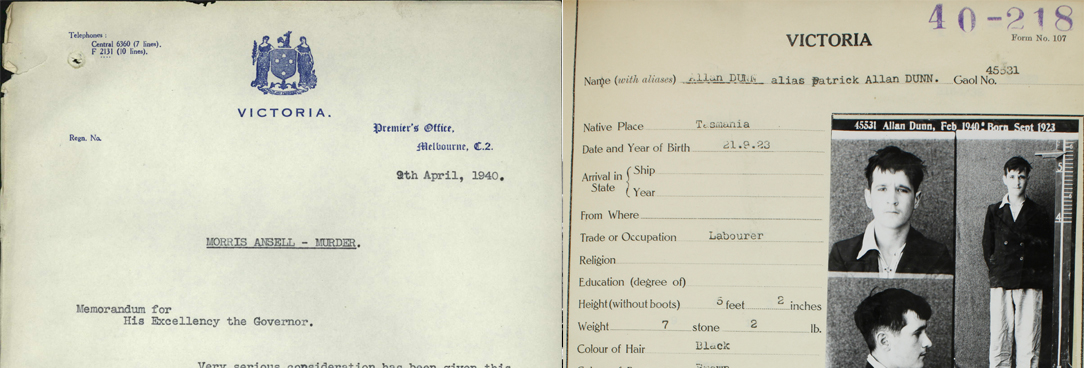
Author: Tara Oldfield
Senior Communications Advisor
As of the 1st of January, hundreds of records relating to Victoria’s history have been made public as part of Public Record Office Victoria’s annual opening of officially closed records. The records are of particular interest to family historians waiting on files that mention members of their family tree.
Under Section 9 of the Public Records Act 1973 files of a personal or private nature are closed for up to 99 years to prevent the violation of personal privacy. Director and Keeper of Public Records, Justine Heazlewood, said this year’s openings provide us with an insight into parts of Victorian history which have been obscured for many years.
“These newly opened records provide a snapshot into our history previously unseen. From 1915 Children’s Court and ward registers to 1940 asylum records, criminal trial briefs and capital case files - through these annual openings we can find out more about ourselves and our past,” said Ms Heazlewood.
Included in this year’s openings is the capital case file of murderer Morris Ansell whose death sentence was commuted to life imprisonment on the 10th of April 1940. According to the transcripts within this file, the jury requested mercy for Ansell on account of his youth – he was only 20 years old when he shot and killed his lady love’s husband.
The Head Nurse’s Daily Report Book from Kew Mental Hospital’s Female Wards is also an interesting record detailing activities within the mental hospital from the year 1940. Her daily report included notes such as who was injured, ill, violent, or out on trial with further remarks about patient conditions.
“We encourage Victorians to explore their past through our archives, whether that be tracing your family roots, researching your home or community, or simply discovering a particular time in Victoria’s history to better understand the present,” said Ms Heazlewood.
A broad guide to time periods for closure under Section 9 is as follows:
- Records primarily concerning adults may be closed for 75 years from the year in which the records were created.
- Records concerning children as the primary subject of the record may be closed for 99 years from the year in which the records were created.
- Records such as staff records where the individuals concerned may still be in the workforce may be closed for a lesser period such as 30, 40, or 50 years as appropriate.
See below for a full list of opened records:
- Criminal Trial Briefs, Office of Public Prosecutions, 1940 (Units 2871-2927)
- Criminal Record Books, Supreme Court of Victoria, 1929-1940
- Inward Registered Correspondence, Attorney-General's Department, 1939-1940 (Units 18-34)
- Divorce Case Files Melbourne, Supreme Court of Victoria, 1939-1940 (Units 302-319)
- Secretary's Inward Registered Correspondence, Victorian Railways, 1979-1983
- Central Register of Male Prisoners, Penal & Gaols Branch, 1939-1940
- Register of Names, Particulars and Personal Descriptions of Prisoners Received, Pentridge Gaol, 1939-1940 (Units 73-75)
- Index to Register of Prisoners Received, Pentridge Gaol, 1937-1940
- Divorce Case Files Ballarat, Ballarat Courts, 1940
- Examination Registers (Technical Subjects), Education Department, 1970-1985
- Capital Sentence Files, Governor, 1940
- Children's Court Register, Richmond Courts, Jan 1915-Feb 1916
- Criminal Trial Brief Register II, Office of Public Prosecutions, 1940
- Children's Court Registers, Ballarat East Courts, July 1914-July 1916
- Master Patient Index Cards, Alfred Hospital, 1938-1940 (Units 103-109)
- Children's Court Registers, Fitzroy Courts, July 1915-Feb 1916
- Post Mortem Registers, Royal Park Mental Hospital, 1937-April 1940
- Head Attendant's Daily Report Books (Male Department), Kew Mental Hospital, Sept 1939-Oct 1940
- Trial Leave Registers, Mont Park Mental Hospital, June 1920-Dec 1940
Material in the Public Record Office Victoria archival collection contains words and descriptions that reflect attitudes and government policies at different times which may be insensitive and upsetting
Aboriginal and Torres Strait Islander Peoples should be aware the collection and website may contain images, voices and names of deceased persons.
PROV provides advice to researchers wishing to access, publish or re-use records about Aboriginal Peoples
